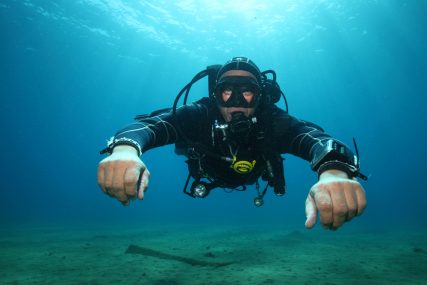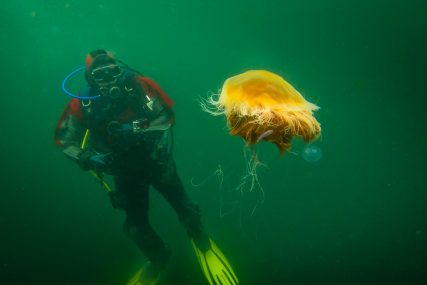Neutral Buoyancy in a Dry Suit: An Interview with Alexis Vincent by Claudia Perucchini
Whenever I read about ice diving, or hear about the latest Antarctica diving expedition, I imagine submerging myself in ice cold water and embarking on a frosty adventure. And that’s where the daydream ends. Despite the fact that I took my first dive in the UK in a 7-millimeter wetsuit, I consider myself a wholly tropical fish. I realized very early on that the British waters were too cold for me, and wisely moved to the Caribbean where I found the warm water temperatures much more to my taste.
Alexis, on the other hand, started his diving career in the magnificent yet very chilly waters of Canada. For him, a dry suit was standard equipment. I remember being fascinated by this bizarre-looking piece of equipment. As a non-diver at the time, I had no idea what all those valves were for, and why it looked a bit like something an astronaut might wear.
I’ve often heard Alexis telling his students that if you learn to dive in cold waters in a dry suit when you dive in warm waters it’s a much easier transition than the other way around. Of course, this is true for other aspects of diving, like learning in stressful conditions such as poor visibility or rough weather. It makes you a stronger diver in the long run.
I have always wondered, however, what it would be like to do the transition the other way around. I learned to dive in tropical waters with great visibility, and have never used a dry suit. What would it be like to train in a dry suit, to learn how to use new equipment, perform different safety procedures and above all to achieve neutral buoyancy in a dry suit? So to find out, I decided to sit down with Alexis Vincent, Managing Director of Dive Butler, to ask him a few questions about cold water diving.

Dry Suits Versus Wet Suits
The first thing I want to know about is the alien-looking dry suits. “There are some basic differences between a wetsuit and a dry suit,” Alexis tells me. “A wetsuit allows water into the suit and, with proper fitting, the water will remain inside, slowing down heat loss. A dry suit, on the other hand, stops the water coming in altogether, keeping the diver completely dry.”
I quite like the idea that undergarments can be worn under the dry suit, keeping the diver warm and dry. But proper fitting is crucial to achieving this, as Alexis explains. “It needs to have proper seals to prevent water from coming in,” he says. “The whole idea is to slow down heat loss. The air inside the dry suit creates a layer of insulation and helps keep the diver warm.”
The risks of diving in cold water should never be underestimated. Hypothermia can happen in just a few minutes. To prepare for dives in these types of conditions, it is paramount that divers train in safe environments.
The Basics of Neutral Buoyancy in a Dry Suit
Buoyancy is my biggest concern when it comes to dry suit diving, so I ask Alexis how he learned to control his buoyancy. “I practiced a lot in the swimming pool first,” he explains. He emphasizes that it’s essential to do dry suit training in a swimming pool or confined water environment, as the suit is an additional part of the equipment. “The dry suit is connected to the air the tank, it affects buoyancy, and it has to be used in addition to the BCD for buoyancy control.”
Air will always concentrate in the upper part of a diver’s equipment, whether that’s the BCD or the dry suit, according to Alexis. “It is important to make sure a diver doesn’t have too much air in the dry suit, as this can migrate to areas such as the feet, creating what is known as a feet-first runaway ascent.” What this means, he explains, is that too much air can concentrate around the lower limbs and bring the legs upwards. It is more difficult to dump air from a dry suit than a BCD, so this situation needs to be avoided.
So how does a diver begin training with a dry suit? “A diver should start with small amounts of air in the suit for comfort and warmth, but just enough to avoid squeeze,” Alexis says. “As the diver descends, the water pressure will compress the air in the dry suit, so air adjustments have to be made to both the suit and the BCD.”
I ask if it’s difficult to manage so many dump valves at one time. “Like anything, practice makes perfect,” Alexis smiles. “The more a diver practices in a safe and confined environment before going out into the cold ocean, the better they will feel.”
Buddy Checks When Dry Suit Diving
Regardless of experience, diving in cold water is a totally different game. You need to have more weight on you, and be prepared to manage it to achieve positive buoyancy at the surface and neutral buoyancy underwater. Training in a pool is a great way to learn how to prepare your equipment, to perform safety and buddy checks and to test the equipment. So what sort of checks does a diver need to make, I ask?
“There must be no leaks from the suit’s seals,” Alexis begins. “And you need to adjust the amount of weight you will need to compensate for the extra air in the dry suit. You need to check that both low-pressure connectors are working properly, and can be easily disconnected and reconnected from the dry suit in case of a problem.”
So let’s get technical for a moment. In order to inflate a dry suit, a diver has to press a valve button, usually located on the chest of the suit. The valve is connected to the tank via a low-pressure inflator hose, the same kind as the BCD’s inflator hose. The dry suit hose connects to the suit valve with a slip-coupling device. In short, there’s a lot to keep track of.
“It’s extremely important to check the connection and ensure the valve works before entering the water, and again as part of the buddy check,” Alex says.
There are other factors to consider too. When you dive in a dry suit you are wearing neoprene or dry gloves, which makes maneuvering the equipment with your hands a bit more complex. On top of that, the water is cold, so automatically your movement is slower and clumsier, so if a diver forgets to connect his suit to the low-pressure hose before entering the water they can be in trouble.
More Tips on Neutral Buoyancy in a Dry Suit
I return to the feet-first ascent scenario that Alexis has mentioned, and ask him how a diver can prevent it from happening and what they can do if it does. “All drysuits come with dump valves, like the BCD,” he begins. “Depending on the model and style of the dry suit, the dump valve can be located on the shoulder, elbow or arm.” As with all new equipment, a diver will familiarise themselves with the equipment and learn how to use it. Controlling your buoyancy, however, comes with practice.
There are two schools of thoughts and two types of dry suit diver, Alexis explains: there are those who use the dry suit only to control buoyancy underwater; and those that use both BCD and dry suit. As with any diving skill, the more practice a diver gets in dry suits, the more they will know how to manage the equipment and adjust it to compensate for the changes of water pressure. The end goal is to be comfortable maneuvering multiple low-pressure hoses and dump valves to add or release air from the BCD and suit.
Alexis reiterates his earlier point about avoiding trapped air, which can migrate to the feet. “In the swimming pool we learn a technique called a tuck and roll,” he says. “This technique should be applied as soon as the diver realizes their feet are upwards, to prevent or minimize an uncontrolled fast ascent. The tuck and roll involve performing repeated quick pulses to bring the knees towards the chest in order to create enough force to bring the diver into an upward position again. This allows them enough time to be able to release the excess air using the dump valves and achieve neutral buoyancy in a dry suit. If this is not enough to get the diver in an upward position, they can roll forward, and once the upper body is above the legs they dump the air fast to resume neutral buoyancy.”

Cold Water Diving and Biodiversity
After all this talk of equipment and new diving techniques, I want to ask Alexis what it actually feels like diving in cold water. What is the appeal?
“I loved diving in Canada,” Alexis says enthusiastically. “It was my very first diving experience and the beginning of a lifetime passion.”
Even though he hasn’t dived in British Columbia in many years, Alexis has great memories of his experiences there. “I saw marine life that is completely different to what you find in tropical waters,” he says. “Like the giant octopus! The landscape is gorgeous both above and below the surface, and sometimes I was lucky enough to have seals checking me out, playing around and spreading the fun.”
Tofino, on Vancouver Island, remains Alexis’ favorite place to go cold water diving. In fact, Jacques Cousteau used to refer to the sea around Vancouver Island as ‘The Emerald Sea’ due to its incredible biodiversity. Tropical water divers like me would be surprised at the diversity they can find in British Columbia. Alexis talks of incredible walls full of sponges, big red sea fans, and colourful soft corals.
It has been an eye-opening talk with Alexis, and I might just be tempted to give cold water diving a try. The challenge of learning new skills, and the chance to dive in completely different environments filled with even more incredible marine life are certainly appealing. I just have to pluck up the courage to tackle that cold water first!
« Neutral Buoyancy and Photography | Diving in Palau: The Pearl of the Pacific » |